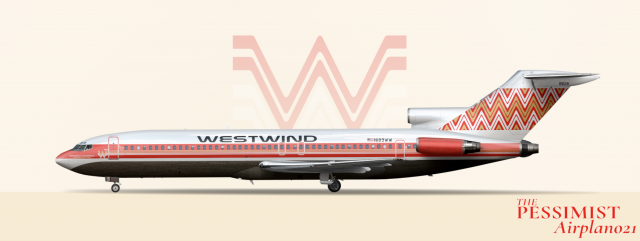
1973 - Boeing 727-200
- Owner: ThePessimist (View all images and albums)
- Uploaded: Mar 14 2024 02:56 PM
- Views: 210
- Album Westwind

In many ways, the 1970s were the end of the golden age for Westwind. The 70s began with a bang as the DC-10 was delivered and then grounded several times in its early years due to various safety concerns. This significantly extended the service lives of Westwind's DC-8 Pacific fleet which should have been sold off shortly after their DC-10 replacements arrived but were instead retained for several years by management paranoid that the DC-10s might be grounded once again. Demand for transpacific travel swelled as the Asian tigers stretched their legs and became real business hubs. Westwind's clockwork military reliability made it a favorite among business customers. Westwind cashed in on their business loyalty with extravagant lounges on aircraft and multi-course meals. The livery which Westwind developed for its modern future reflected this decadence and was impossible to miss amongst other American and Asian carriers. Dennis Martinette, who had painted the "Western Wind Express" titles on the crew's original B-29, thought the livery was tacky and gauche but was overruled by the board. In protest, he resigned from his role as Chief Operating Officer and returned to the cockpit as a flight engineer in the same role he had occupied during the war and the early days of his airline. His departure from management represented the first Westwind founder who had left the project and left Jim, Paul, Raymond, and Walter disappointed but resolved to continue pushing the airline forward. Despite his opposition, Martinette, would play a role in solidifying the 1970s livery of Westwind as an American icon. Extra DC-8s in the Westwind fleet found themselves an increasingly common sight on charter services for the military in 1974 and 75. Because of the priorities of the military, this meant Westwind DC-8s were a mainstay of Saigon and other airports in South Vietnam as the American force draw down in the conflict became increasingly frenzied and urgent. Evacuation flights as the ARVN collapsed were nothing like the flights where Westwind had transported troops to South Vietnam. Flight attendants in high heels offering orange juice were replaced with seats piled with people and equipment and the sound of gunfire. One of the most famous pictures of the evacuation captures a scene of chaos as Martinette reached out of the door of a taxiing Westwind DC-8 to help an air traffic controller aboard one of the last flights out of Tan Son Nhut Air Base in Saigon in April of 1975. The photo had the result of plastering Westwind's livery on the front of every America newspaper.
Back at home, Westwind's massive fleet overhaul in widebody aircraft could have gone unnoticed in smaller western communities served by Westwind. Trusty Lockheed Electras remained a mainstay of the fleet long after the type had been retired by Westwind's competitors. 727-100s were joined by a small number of larger 727-200s which took over Westwind's triple star trunk service connecting San Diego, San Francisco, and Phoenix. Westwind was interested in modernizing the fleet further but was unhappy with the size and efficiency of competitors. Raymond McKenna, who believed for reasons entirely inexplicable that his experience as a naval air service pilot made him an aircraft design connoisseur, compared Boeing's smaller, more efficient, 737 line unfavourably to a pig. Raymond also excoriated the DC-9 as an under-engineered flying RV. Westwind did explore the possibility of adding to its fleet with alternative aircraft and ultimately came quite close to a large order for Dassault's intriguing Mercure, but a test airframe lent to the airline proved that it was not efficient enough to offset its serious range limitations. Raymond remained committed to the program though and sowed the seeds for what would be Westwind's eventual A320 order.
By the late 1970s, the original founders were beginning to age and one by one retired leaving their various appointed successors. Even though they were leaving, they ensured that their replacements were strong adherents to their understanding of how the airline should be run. Most of the next generation were still military men largely from the various Navy air positions and so even though the board appeared to get younger, it remained determined and committed to its roots in the military. This was concerning, though, because it further isolated Westwind from other airlines in terms of management style. It instilled on certain board members a sense that they were the chosen ones meant to preserve the airline which made the airline less flexible and more rigid in its scheduling and organization,

 Sign In
Sign In Create Account
Create Account










